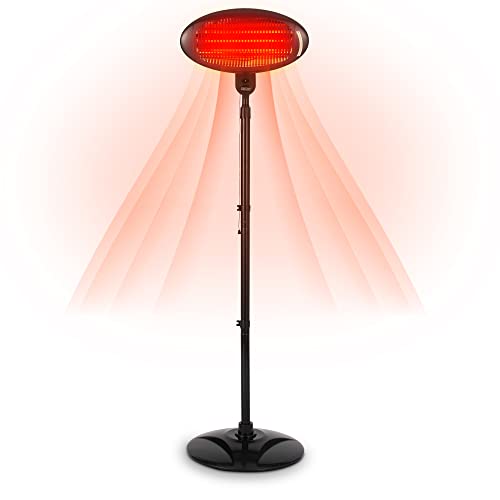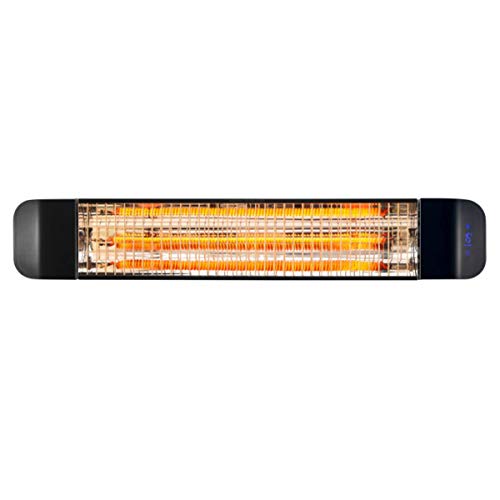See What Gas Fired Patio Heaters Tricks The Celebs Are Using
Gerardo
0
21
2024.11.25 22:51
 Gas Fired Patio Heaters
Gas Fired Patio HeatersGas-fired patio heaters are becoming more popular for residential and commercial outdoor spaces. They are typically freestanding and have a reflector dome or shield to direct radiating heat downwards.
 They typically connect to natural gas lines and eliminate the necessity of propane tanks and reducing the running costs. They are less mobile and more susceptible to strong winds than propane models.
They typically connect to natural gas lines and eliminate the necessity of propane tanks and reducing the running costs. They are less mobile and more susceptible to strong winds than propane models.Efficiency
Patio heaters are known for extending outdoor dining spaces into the cold months, however they can also be dangers to fire if they are not employed in a safe manner. The Technical Standards & Safety Authority and the Ontario Association of Fire Chiefs warn that patio heaters could cause fires or carbon monoxide poisoning and even death if they are not set up, operated or maintained properly. The good news is that there are simple steps you can take to prevent these dangers.
The first thing to do is check the heater for proper ventilation. Patio heaters that make use of natural gas or propane emit dangerous carbon monoxide. You should not use these heaters inside or in enclosed spaces. Don't store tanks of propane inside. Propane tanks are designed to be used for a specific amount of time and, if kept long-term, it can cause rust. Instead, make sure you have a propane tank cover, or that your heater is vented when not in use.
The type of fuel used and environmental conditions can also influence the efficiency of heat. These are important as windy weather can disperse the heat, while lower ambient temperatures require more energy to keep the warmth.
The design of the patio heater is important. This will impact its ability to heat and the power it generates. Freestanding models are less efficient than models mounted. Certain models are equipped with reflectors that help to increase the heat output and increase efficiency.
It is also essential to verify their power output prior to use them. This will ensure that they can provide sufficient heat for your area, and also ensure that you don't waste electricity or gas. You might need more British Thermal Units if you have an extensive patio or wish to warm an outdoor event.
For bars, restaurants hotels, and other hospitality establishments, the versatility of gas fired patio heaters is what makes them a preferred choice. They can be powered by liquid propane or gas and connected to standard electrical outlets. These heaters are usually more efficient than electric patio heaters in larger spaces due to the fact that they can be controlled remotely or via an alarm clock. They also look better than other types commercial heaters and are perfect for areas that require a modern and stylish appearance.
Safety
Gas-fired patio heaters can be used in restaurants or at homes to provide warmth and comfort in colder weather. To avoid injury or fire hazards, they must be used and maintained correctly. Make sure your heater is UL-listed or Canadian Standards Association-listed and has a flame failure system that shuts off the gas powered patio heater in the event of a burner tipping over.
It's important to also be aware of the instructions and warnings of the manufacturer, especially those that concern the use of fuel. You should also have an extinguisher for fire in case of any accident that might occur. It is recommended to have a extinguisher of class B or C in accordance with the type of fuel your heater is using and an empty water bucket.
Gas patio heaters are generally free-standing and should be kept at a minimum of one foot away from flammable materials such as tent walls, gazebos, or tablecloths. Also, ensure they're not placed near an exit or in close proximity to any mechanical air intakes on buildings.
In addition, as the heaters are typically placed at high elevations in order to spread heat over an area, they could be top heavy and susceptible to falling over or tilting. Therefore, it is recommended to secure them in a method using sandbags, or water weights to support them.
To avoid burning To avoid burns, keep pets and children at least three feet away from heaters. You should also never leave them unattended or turn them off when you aren't in the immediate area. Only use natural gas heaters that have been endorsed by your local plumber and are in good shape.
Gas patio heaters are also affected by wind depending on the type of fuel. A strong wind can blow the propane cylinder away or cause a fire to go out in the case of a model that has an propane cylinder. Propane and natural gas models with a hose attached must be connected to a long-lasting gas line and installed outside to limit the chance of fire or explosion.
Comfort
Patio heaters come in a variety of styles, and powered by various fuel sources. The ideal one for your home will depend on the dimensions of the space you'd like to heat, the power source available and your preferences in terms of appearance and control.
Gas-powered patio heaters are able to warm an area faster and with more heat than other types of heaters for patios. Thomas Bonfiglio is the CEO and founder at Triple T Hospitality. He states that this is one of the many reasons that his restaurants in New York and New Jersey employ pyramid-top and dome-top patio heaters. "The high heat output allows us to keep our customers cozy while they enjoy dining outdoors during the winter," Bonfiglio says.
Another consideration is the energy efficiency of gas-powered heaters. A heater that has more BTU rating is likely to be able to heat a room quicker and more efficiently than one that has a lower BTU rating. A quick rule of thumb is to multiply the area of your outdoor space by 20 to determine the number of BTUs needed to heat it.
The most sought-after option for homeowners is propane-powered heaters. They can be portable and use standard 20-pound propane tanks (like the ones used to fuel your grill) that are available at a variety of hardware stores. However, propane-powered models typically consume more electricity, which makes them less environmentally friendly than other fuel options.
Electric heaters require plugs to operate. They are also more secure than propane-powered ones, as they don't emit harmful fumes or burn like gas small patio gas heaters. However electric patio heaters aren't as hot as other options and are limited in the they can generate heat.
Natural gas-powered heaters, on the other side, are a good option for those who wish to connect their patio heaters to an existing natural calor gas patio heater line. They require professional installation and may be a bit more costly to run than other kinds of patio heaters. Natural gas heaters are the fastest and most reliable of the three options. This may be a reason to justify the additional cost.
Versatility
There are a variety of options when it comes to outdoor heating with propane. It doesn't matter if you select a freestanding patio heater, firepit, or restaurant-style overhead unit. The key is to adhere to the basic safety rules. These rules can be tricky to master, especially if you are dealing with a flaming flame or hot ashes which can remain hot for up to two whole days. With the right knowledge, however, you can be sure that you're making use of your propane patio heating system safely and efficiently.
Gas-fired patio heaters are an effective and efficient method of heating larger areas, and can cover up to 20 square meters. They operate on either natural amazon gas patio heater or propane and, based on the model, they can be switched on and off via remote control or programmed by timers. They require at least 25 percent of open space to allow airflow to prevent carbon monoxide from building up and causing fatality in the event of not being properly ventilated.
Gas patio heaters, apart from the need for a ventilation space they are generally very simple to operate and maintain. They can be erected permanently in areas that are exposed elements, or they can be recessed into flat roofs. They are typically fitted with an anti tilt switch that will shut the unit off if it senses that the heater is not in a straight position.
In contrast those with wood-burning patio heaters, they are much more difficult to operate and could be dangerous if not operated correctly. The major issue with these types of heaters is that they have to be constantly filled with fuel, and the ash and ash produced should be disposed of in a safe place. They are also harder to ignite and can produce sparks that could cause fire or injury.
No matter what kind of patio heater you opt for, safety should be top of mind in terms of usage and maintenance. Keep a fire extinguisher close by and remind your children to play away from the heaters. Be aware of any unusual smells or changes in temperature that could be a sign of a gas leak. Both natural and propane gases contain mercaptan to produce an unpleasant smell if they leak.





